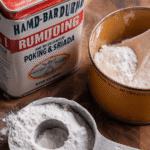Description
🧂 Baking Soda vs Baking Powder are essential leavening agents with distinct chemical properties that impact your baking.
📚 Understanding their differences and uses helps you achieve the perfect rise and texture in your recipes.
Ingredients
– 1 teaspoon baking powder provides leavening and helps batter rise evenly
– 1/2 teaspoon baking soda acts as a leavening agent and balances acidity
– 2 cups all-purpose flour forms the base of the batter providing structure
– 1/2 cup sugar adds sweetness and affects browning
– 1 cup milk moistens the batter and activates leavening agents
– 1/4 cup vegetable oil adds moisture and tenderness
– plant-based milk such as almond or soy milk for vegan options
– gluten-free flour blend for gluten-free alternatives
– natural low-calorie sweeteners like stevia for low-calorie
Instructions
1-Getting the hang of baking powder vs baking soda: starts with a simple, step-by-step process that anyone can follow. First, preheat your oven to 350°F (175°C) and grease your baking pan to prevent sticking, then gather all ingredients measured accurately for a smooth process. This setup ensures your bakes rise just right and avoids any kitchen surprises.
2-Next, in a large mixing bowl, sift together the flour, baking powder, and baking soda to ensure even distribution and eliminate lumps. Baking powder contains baking soda mixed with cream of tartar and often cornstarch, so it activates with liquid alone, while baking soda needs acid like the milk or lemon juice in your recipe. For example, if you’re substituting, use 1 teaspoon of baking powder to replace 1/4 teaspoon of baking soda along with 1/2 teaspoon of cream of tartar or 1 teaspoon of lemon juice or vinegar.
3-In a separate bowl, combine sugar, milk, and vegetable oil, then stir well to blend the wet ingredients and activate the leavening agents. Gradually add the dry ingredients into the wet mixture while stirring gently, ensuring a smooth, lump-free batter, and adjust for dietary preferences by substituting milk or flour as needed. For internal inspiration, check out our delicious lemon oatmeal cookies recipe that uses similar techniques for a fresh twist.
4-Baking and Cooling Steps: Pour the batter into the prepared pan, spreading it evenly, which can be adapted for gluten-free or vegan mixtures without changing baking time. Bake in the preheated oven for 25-30 minutes, checking doneness with a toothpick, and adjust time slightly for different oven types or ingredient substitutions. Finally, remove from the oven and allow to cool for 10 minutes before slicing and serving, ensuring the best texture and flavor. Serve your dish warm or at room temperature, optionally garnished with fresh fruits or nuts to enhance presentation and taste.
Notes
⚖️ Use proper measurements to ensure correct chemical reactions and texture.
🍋 Adding an acid with baking soda is necessary for leavening.
🧁 Baking powder is a complete leavening agent suitable for recipes lacking acidic ingredients.
- Category: Baking Basics
- Method: Mixing and chemical leavening
- Cuisine: Universal
Keywords: Baking Soda, Baking Powder, Differences, Uses
